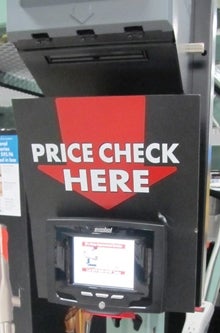Consumers may not realize the steps Massachusetts retailers must take to avoid slapping a price tag on every single item they sell in their stores.
To avoid the time-consuming and costly measure, state law requires stores to provide in-aisle electronic scanners so customers can check prices on their own.
Each scanner, separate from those at check-out registers, must be attached to a printer that can print and affix a price tag to an item. And there must be one scanner for every 5,000 square feet of sales floor space.
Paula Rosenblum, an analyst with Florida-based Retail Systems Research, said retailers change item prices more frequently these days than ever before, which makes it challenging to efficiently show accurate prices.
“It’s not cheap to re-price everything,” Rosenblum said.
To solve that problem, retailers use display pricing and electronic scanners connected to their internal computer systems to display accurate prices.
To protect consumers, the state likes to keep tabs on how well those scanners are working.
Barbara Anthony, undersecretary of the state Office of Consumer Affairs and Business Regulation, said her inspectors tend to visit stores at the start of the holiday shopping season in November. It’s a busier time of year, leading up to the holiday shopping season, when retailers are busy with customers and may not be ensuring scanners are working correctly.
State inspectors visited 46 stores across the state in November. Of the stores inspected, 10 were in Central Massachusetts, including Target in Berlin, Worcester and Millbury; BJ’s Wholesale Club in Hudson; Walmart in West Boylston; Sears, Macy’s and Toys R Us in Auburn; and Best Buy and Kohl’s in Millbury.
Inspectors found that more than 45 percent of the scanners statewide did not meet the state’s standards. Some were unplugged, some were broken, and others did not have printers attached for shoppers to print and affix price tags to their goods.
The violations could be referred to Attorney General Martha Coakley, who could pursue fines, but Anthony said she doesn’t expect that to happen.
“Our intent is to educate and get these scanners up and running properly so consumers can know the price of an item,” she said.
Too Busy To Notice?
Rosenblum, the retail analyst, said she doesn’t think retailers are doing anything nefarious in sometimes letting scanner maintenance fall by the wayside.
She said inspections that take place right as the shopping season gets into full swing will catch stores at their busiest. “By then, the last thing on somebody’s mind in a retail environment is using some store payroll to get the scanners working,” she said.
Retailers had far better results in a separate inspection, also performed in November, of the scanners’ pricing accuracy. More than 99 percent of the in-aisle scanners reflected accurate prices when they were cross-checked against the check-out register prices. A separate state law requires at least 98 percent accuracy.
“I think most retailers do a good job in terms of accurately pricing,” Anthony said.
Of the 13 overcharge errors discovered in a check of more than 2,400 items at 84 stores, 12 errors were by a difference of $1.50 or less. The state seems to be taking pricing errors more seriously than other violations. It plans to pursue $1,500 in fines for four stores that did not pass inspection, none of which was in Central Massachusetts.
Accurate Pricing Is Important
Bill Rennie, vice president of the Retailers Association of Massachusetts, said retailers want their systems to work well and reflect accurate prices because it keeps customers happy.
He thinks accurate pricing is more important than some price tag printers that don’t work. It’s not clear how many consumers utilize the scanners. Rennie ventured that in his shopping experience, many consumers likely look only at the display price.
“More often than not you’re going to find the item on the shelf and the price of the item is right on the shelf,” he said.
One major retailer seems to agree on the importance of pricing accuracy.
Asked to respond to inspectors’ findings that 43 of its 95 scanners had non-pricing-related problems, such as being unplugged or having a printer that wasn’t working, a Target spokesman said in an email: “Target is committed to accurate pricing. We constantly strive to ensure price accuracy and have processes in place to ensure our systems are reflecting the appropriate prices for our guests.”
Kelly McFalls, a spokeswoman for BJ’s, where 22 of 26 scanners inspected passed, said the wholesale club operator uses a combination of oversized signs on shelves and scanners to display prices to members.
“To place a sticker on every item would translate to hundreds of man-hours, which would be passed on in the form of higher prices,” she said.
Tom Lavergne, manager of Best Buy’s store at the Greendale Mall in Worcester, said many customers don’t seem to use the scanners.
“It’s kind of there on the off chance something’s in the wrong spot,” Lavergne said. “More often, customers will ask about a price.”
Though he and his employees change prices frequently in the store, Lavergne said he is happy to not have to price every item.
“I’m sure that would take a lot of time,” he said. “It’s not something that’s ever really seemed necessary.”
In the fast-moving world of technology, scanners are ancient, Rosenblum said. The devices have been prevalent in stores since the 1980s, and she expects scanners to be replaced in the coming years by more modern technology, such as RFID (radio frequency identification) tags installed in shopping carts, or mobile phone applications tailored to brick-and-mortar retailers.
But the emergence of smartphone applications in recent years that allow consumers to comparison shop by scanning bar codes of items in their stores has frustrated retailers.
“If retailers had their way, they’d cover their stores in tinfoil so you couldn’t get a signal,” Rosenblum said.

